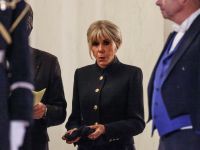Climbing a chair and embracing his equipment and brushes in the middle of a university in Tunisia’s central governorate of Kairouan, young Tunisian artist Safwan Miled puts the latest touches on his mural, whose decorated Arabic lettering and beautiful colours brim with life.
With confidence, the 30-year old Tunisian artist stands and contemplates his painting, which makes the walls and domes of Kairouan sparkle with Arabic calligraphy and drawings.
Eager to preserve Kairoun’s specific Islamic cultural identity and utilise its renowned Kufi calligraphy, Miled often combines the calligraphy form with modern art techniques. The calligraphy styles he uses, which emerged in the 5th century AH (11th century AD), is characteristic of Islamic art and was often used on famous blue parchment manuscripts.
The blue parchment made of deerskin decorated with traditional gold water in Kufi letters dates back to the era of the Zirid dynasty, which ruled North Africa from 972 AD to 1152 AD, and is preserved by the Raqqada National Museum of Islamic Art in Kairouan. The treasures are some of the institution’s rarest, most expensive and historically significant artifacts.
Miled explained that “Arabic calligraphy has a formal, civilised and aesthetic dimension, and if it is combined with colours, it gives a third dimension, which is artistic creativity.”
He stressed that he hopes to revive the heritage of Arabic calligraphy, which he fears is disappearing, and noted that he has developed a spiritual connection and personal relationship with the art form after growing up in the home of an artist that helped him master the technique.
Miled’s father is Tunisian artist Khaled Miled. From his father’s studio, he took his first steps in the world of art. He eventually learned how to work with brush, wood, leather, porcelain and other materials, transforming them from silent inanimate objects into talking paintings and art works.
After visiting art galleries in Tunisia and other countries, Miled’s artistic ambition grew and he sought to expand his horizon.
In Kairouan, Miled said he wanted to make his paintings open to the public in streets and squares rather than restrict them to closed spaces, entry landmarks or requiring people to purchase tickets to see his works.
By creating murals to decorate the walls of the city, the artist has filled many public spaces with his letters, sketching artistic icons on prominent historical landmarks.
Thanks to his touches on the domes of the ancient city, especially those adjacent to the Grand Mosque of Kairouan (built in the year 50 AH), drawings with the colours of the sky make them appear as though they are swimming in one horizon, expanding in front of the viewer with the minaret of the mosque.
Despite setbacks from the coronavirus crisis and intense competition in the artistic space, Miled has been able to find support to continue pursuing his artistic vision to preserve Kairouan’s ancient heritage with young students and art hobbyists.
But Miled’s ambition is not limited to his local space, as he strives “to spread the culture and art of Arabic calligraphy in the world.”
This article has been adapted from its original source.








